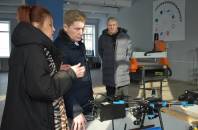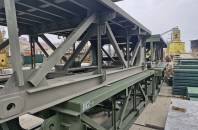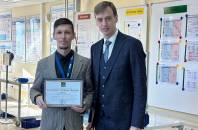|
Региональный журнал для деловых кругов Дальнего Востока
|
|
||||||||||||||||||||||
|
Понедельник| 17 Ноября, 06:54 |
|
|
Тема номера
|
|||||||||||||||||||||

 Олег Кожемяко осуществил новогодние желания маленьких приморцев
В преддверии новогодних праздников заветные желания маленьких приморцев начинают сбываться. Так, Губернатор Приморского края Олег Кожемяко передал подарки от Деда Мороза двум маленьким приморцам: шестилетнему Мирону Глушаку из Тернейского муниципального округа и четырёхлетней Ольге Алимпиевой из Арсеньева.
Олег Кожемяко осуществил новогодние желания маленьких приморцев
В преддверии новогодних праздников заветные желания маленьких приморцев начинают сбываться. Так, Губернатор Приморского края Олег Кожемяко передал подарки от Деда Мороза двум маленьким приморцам: шестилетнему Мирону Глушаку из Тернейского муниципального округа и четырёхлетней Ольге Алимпиевой из Арсеньева.
 Родители ребят с ОВЗ обсудили вопросы образования и трудоустройства с представителями власти Приморья
Третья встреча клуба "На равных", призванного помогать гражданам решить непростые жизненные ситуации, состоялась в Приморье. В этот день участниками клуба стали родители детей с инвалидностью и ограниченными возможностями здоровья. Они обсудили с представителями власти вопросы образования и трудоустройства таких ребят.
Родители ребят с ОВЗ обсудили вопросы образования и трудоустройства с представителями власти Приморья
Третья встреча клуба "На равных", призванного помогать гражданам решить непростые жизненные ситуации, состоялась в Приморье. В этот день участниками клуба стали родители детей с инвалидностью и ограниченными возможностями здоровья. Они обсудили с представителями власти вопросы образования и трудоустройства таких ребят.
 Социальные предприниматели Приморья могут найти кадры и получить рекламу на радио при господдержке
Открыт прием заявок на две актуальные для социальных предпринимателей меры поддержки: "Размещение двух вакансий на HeadHunter" и "Размещение рекламы на радиостанции". Такой формат господдержки поможет социальному бизнесу Приморья продвигать свои услуги в осенний период и найти профессиональные кадры для расширения штата.
Социальные предприниматели Приморья могут найти кадры и получить рекламу на радио при господдержке
Открыт прием заявок на две актуальные для социальных предпринимателей меры поддержки: "Размещение двух вакансий на HeadHunter" и "Размещение рекламы на радиостанции". Такой формат господдержки поможет социальному бизнесу Приморья продвигать свои услуги в осенний период и найти профессиональные кадры для расширения штата.
 24 протокола составили на нарушителей противопожарного режима в приморских лесах
Лесничие и инспекторы в Приморье составили 24 протокола в отношении нарушителей особого противопожарного режима на землях лесного фонда. ОПР действует в большинстве муниципалитетов и подразумевает крупные штрафы за пренебрежение правилами пожарной безопасности.
24 протокола составили на нарушителей противопожарного режима в приморских лесах
Лесничие и инспекторы в Приморье составили 24 протокола в отношении нарушителей особого противопожарного режима на землях лесного фонда. ОПР действует в большинстве муниципалитетов и подразумевает крупные штрафы за пренебрежение правилами пожарной безопасности.
Khabarovsk Region:Industrial and transportation hub for the Russian Far East
Vyacheslav SHPORT,Governor, Khabarovsk Region:
"The Khabarovsk Region’s economy is more diversified than the other regional economies in the Russian Far East. Our region is a multi-industry inter-regional transportation hub, which, together with our natural resources and industrial base, enables us to develop a broad range of sectors.
The regional system for raising investment has been transformed significantly in recent times to match investors’ needs more closely. Investment in fixed assets in the region was RUB 176,654 million in 2011, with investment in infrastructure accounting for about 50% of the total.
We were the first region in the RFE to sign an agreement with the Agency for Strategic Initiatives to introduce standards to improve the investment climate and implement roadmaps that make it easier for investors to operate in our region. Last year, our legislature passed the law “On Government Support for Investment Operations in the Khabarovsk Region.”
We are constantly expanding the range of benefits we offer to investors. The list includes tax breaks, tax investment credit, a system of guarantees for banks, support in resolving administrative issues, and a range of other measures making it easier to build facilities and launch companies in the region.
The Khabarovsk Region welcomes cooperation in setting up production facilities in all sectors of the economy, and we are ready to offer investors special terms and the full support of the Regional Government".
Aircraft and sea-going vessels combined in a cluster
Gagarin Komsomolsk-on-Amur Aircraft Production Association (KnAAPO) is one of the largest aircraft manufacturers in Russia and worldwide. It makes combat aircraft including the Sukhoi Su-27, Su-30M2, Su-30MK2 and the Su-35, used by the Russian military and the air forces of nations worldwide. Ongoing technical and technological refinements, plus the strong skills of employees, have earned the company a government contract to create a fifth-generation frontline aviation complex under the provisional T-50 designation. The first trial versions of future aircraft have already taken off from the company airfield.
KnAAPO is using its experience to design and build Sukhoi’s first commercial airliner, the regional Sukhoi Superjet SSJ-100. A division of Sukhoi Commercial Aircraft: the design bureau for the regional jet, was established at KnAAPO to make some of the airliner’s components and do the final assembly of the regional jet from parts made around the world under international contracts.
The company has promising new opportunities associated with construction of Vostochny Space port in the Amur Region, where KnAAPO may work on the design and construction of spacecraft components.
Shipbuilding is another strong sector in the Khabarovsk Region. Major shipyards include Amur Shipyard (in Komsomolsk-on-Amur), with production facilities and technologies for civil and military ships and vessels of different types, including nuclear submarines displacing up to 25,000 tons; Khabarovsk Shipyard builds surface vessels of all types and classes (steel and alloys) displacing up to 2,000 tons. Today, these companies receive orders for military and civil ships, supported by Moscow and our regional government, which helps them boost output and upgrade and retool their production facilities.
The aircraft and shipbuilding cluster on the drawing board developed by the Khabarovsk Regional government should enable companies in the cluster to exchange advanced technologies, provide impetus for development of production facilities in engineering, including steelmaker Amurstal and cable-rolling Amursk Cable Plant. The project has been approved by the Russian Federal government, and the regional government will soon launch its implementation.
Transportation as the key link
One of Khabarovsk Region’s advantages is its unique location in terms of transportation and logistics accessibility for trade and cargo flows in the RFE for trade between the RFE and European Russia, and for developing international trade between Russia and APEC countries. All the major Russian railroads and highways transit through the Khabarovsk Region carry oil and gas from Siberian and RFE fields to ports in Primorye. Khabarovsk Region also has river and sea transport with access to world sea lanes.
Two major railroads cross Khabarovsk Region: the Transsiberian Railway, connecting Moscow and European Russia with southeastern border regions, and the Baikal-Amur Mainline, providing a more northerly route to the Pacific ports of the Khabarovsk Region (Vanino, Sovgavan) and making it possible to tap the rich resources of Eastern Siberia and Yakutia. Both railroads are being developed aggressively, opening new growth opportunities for the regional economy.
Khabarovsk Airport’s potential as an air transportation hub is demonstrated by the fact that it is the first airport in the RFE where an overseas company has taken an equity stake: Korean government-owned Incheon Airport Corporation, which manages the eponymous airport has been recognized as the world’s best airport for several consecutive years. Incheon Airport management is involved in designing and implementing plans for the Khabarovsk (Novy/New) Airport.
The Khabarovsk Regional government supports integrated development and is making strong efforts to upgrade the inter-regional air transport system to increase access to remote areas of the RFE. The benefits and location of Khabarovsk should reinforce its position as an inter-regional hub for the RFE, making it an important component in the logistics of international passenger and cargo air transportation.
The road from Chita to Khabarovsk has been completed, the last link in the chain of highways connecting Moscow and Vladivostok, and the government of the Khabarovsk Region is working on projects to further expand the regional road network and increase the efficiency of the road. Construction is under way on a highway connecting Lidoga and Vanino, opening the ports of Vanino and Sovgavan to Russian trucking in 2015. Development of Greater Ussuri Island, a Russian-Chinese project, goes hand-in-hand with expanding the transportation infrastructure. The new highway will open a cross-border trucking corridor from China’s Fuyan Town in Heilongjiang to sea lanes via Vanino and Sovgavan. Another highway being built to Nikolaevsk-on-Amur will increase the diversity of local transport opportunities.
A system of natural gas and oil pipelines is a recent addition to the regional transportation system. The Sakhalin-Khabarovsk-Vladivostok gas pipeline and the ESPO oil pipeline connect the oil fields of Eastern Siberia to the Pacific Coast of the Primorsky Region. Construction of another major gas pipeline connecting the large Chayanda gas field in Yakutia with southern Primorye will also have impact the Khabarovsk Region, where two major gas pipelines would come together following the same path south.
Focus on processing
Khabarovsk Region, like most other regions in the RFE, has extensive resources, and the regional government is targeting resource processing as a goal for development of the regional economy.
The O&G pipelines in the region make it possible to expand oil refining and set up facilities for other ways to process hydrocarbons. The Khabarovsk and Komsomolsk refineries supply refined petroleum products to the entire RFE; linkages to refineries up to the ESPO pipeline route should provide a significant competitive advantage, replacing feedstock deliveries by rail, giving them room for continued technical and technological development, and enabling them to set up petrochemical production facilities. Both refineries are undergoing upgrades and adding new types of product lines.
The regional government intends to encourage creation of gas-based chemical manufacturing to take advantage of the resources offered by the new gas pipelines. Five potential sites have been identified for chemicals production facilities, and negotiations with prospective investors are under way.
The region is also focusing on the processing development of its timber and lumber industry. Khabarovsk Region has 6% of Russia’s timber resources and is third nationwide and first in the RFE in timber harvesting. However, the local government’s main objective is not harvesting, but rather developing and expanding timber and lumber processing facilities by creating larger production companies. To achieve this, five large investment projects have been drafted and presented to investors; implementation of three was completed by mid-2012, with two others still under way. Khabarovsk Region processes about 30% of the timber harvested locally: up to 1.6 mcm. Once the new timber and lumber processing facilities reach full capacity, processing volume should increase to 5 mcm, which would enable the region to reach sawed lumber volumes of about 2.2 mn cubic metres (not seen since 1991). There are other timber processing projects in the pipeline, including projects opening new prospects for use of the region’s timber resources.
Khabarovsk Region contributes more than 7% of Russia’s gold output. Refining and processing projects in the sector receive priority government support. Construction of a partial oxidation plant in Amursk by Polymetal is one priority project. The new facility will process gold-containing ore delivered from the on-site flotation concentrator at the Albazino mine.
Intellectual potential
Khabarovsk Region has strong research and scientific potential to support local manufacturing industries with innovations, a large proportion which come from engineers and designers employed by manufacturers, which makes their inventions highly practical. Up to 75% of invention patents, useful models and software - intellectual property originating in the RFE is used in the Khabarovsk Region; the regional government is encouraging innovation by local companies, creating a solid support infrastructure and making the terms for implementation of innovation more attractive.
The regional government is doing all it can to create a modern system for training skilled labor capable of reacting proactively to future demand for labor local companies. Many components of this system are already in place, delivering results, making it possible for local companies to have a necessary reserve pool of skilled labor, and organizing advanced training for skilled staff members.
The efforts of the regional and local government to shape a modern environment for the population play a significant role in establishing a base for the growth and enhancement of the region’s HR potential. Khabarovsk has been recognized as one of Russia’s the livable cities in Moscow’s rankings for several years in a row. Khabarovsk is the only city in the RFE where the population is expanding thanks to people moving in from other areas, and the regional government’s successful efforts to make living in the region more comfortable helps local companies attract the skilled workers to the Khabarovsk Region.
Prepared by: Alexander ZUBOV
Investment projects
The Khabarovsk Region has a register of investment projects that includes nearly 400 proposals from various sectors and is online in the Investments section of the regional government website: gov.khabkrai.ru
Integrated projects:
Sovgavan Special Economic Port Zone. The project includes cargo handling, fish processing, ship repair and ship building. The Russian government offers special tax and customs treatment for companies and individuals working in the zone.
Development of Great Ussuriisky Island, including hospitality and entertainment companies, and development of the international exhibition and trade show business.
Building an international air hub for Khabarovsk Airport (new). In addition to expanding the airport’s infrastructure, the project envisages development of areas adjacent to the airport, with planned construction of hotels, a logistics center and other facilities to raise the quality standard of passenger and cargo service.
Development of natural gas-based chemicals production. The project envisages setting up a number of gas processing facilities and associated companies upstream and downstream.
Continued development of lumber processing. The project envisages construction of new lumber processing facilities at existing timber and lumber companies - Arkaim, DalLesProm and others, expanding into new production areas, including pulp production.
Engineering cluster, offering opportunities to invest in companies in engineering, machine-building, and associated sectors.
Please address all inquiries about to investment opportunities to Government of Khabarovsk Region
Ministry for Economic Development and International Relations of Khabarovsk Region
Department for International Economic Cooperation and Investment
Department Director Maxim TARASOV
Tel. 7 (4212) 32 56 70, E-mail: econ@adm.khv.ru
 #ПозывнойКультура: Дед Мороз поздравил участников СВО в госпитале ТОФ с наступающим Новым годом
В преддверии Нового года агитбригада #ПозывнойКультура побывала в госпитале Тихоокеанского флота в субботу, 28 декабря. Для участников СВО, находящихся на лечении и реабилитации, прозвучали музыкальные поздравления. Со словами самых теплых пожеланий подарки военнослужащим вручила заместитель Председателя Правительства Приморского края – министр культуры и архивного дела Елена Бронникова.
#ПозывнойКультура: Дед Мороз поздравил участников СВО в госпитале ТОФ с наступающим Новым годом
В преддверии Нового года агитбригада #ПозывнойКультура побывала в госпитале Тихоокеанского флота в субботу, 28 декабря. Для участников СВО, находящихся на лечении и реабилитации, прозвучали музыкальные поздравления. Со словами самых теплых пожеланий подарки военнослужащим вручила заместитель Председателя Правительства Приморского края – министр культуры и архивного дела Елена Бронникова.
 Губернатор Приморья оценил оснащение Индустриального колледжа в Арсеньеве
Очередной день работы Губернатора Приморского края Олега Кожемяко в муниципалитетах региона начался с посещения Приморского индустриального колледжа в Арсеньеве. Глава региона изучил новое оборудование, на котором готовят специалистов технических специальностей.
Губернатор Приморья оценил оснащение Индустриального колледжа в Арсеньеве
Очередной день работы Губернатора Приморского края Олега Кожемяко в муниципалитетах региона начался с посещения Приморского индустриального колледжа в Арсеньеве. Глава региона изучил новое оборудование, на котором готовят специалистов технических специальностей.
 Комплекты быстровозводимых мостов начали поставлять в Приморье
Началась поставка средних автодорожных разборных мостов (САРМ) для проведения аварийно-восстановительных работ на дорогах Приморья. Всего на следующий год закуплено 11 комплектов. При необходимости комплекты САРМ будут использованы для оперативного восстановления проездов во время паводков.
Комплекты быстровозводимых мостов начали поставлять в Приморье
Началась поставка средних автодорожных разборных мостов (САРМ) для проведения аварийно-восстановительных работ на дорогах Приморья. Всего на следующий год закуплено 11 комплектов. При необходимости комплекты САРМ будут использованы для оперативного восстановления проездов во время паводков.
 Почти 900 сотрудников предприятий Приморья уже владеют бережливыми технологиями благодаря нацпроекту "Производительность труда"
Итоги реализации национального проекта "Производительность труда" и планы на будущее озвучил министр экономического развития Приморья Андрей Блохин на награждении команды Регионального центра компетенций. За четыре года работы нацпроекта реализовано 78 проектов по внедрению бережливых технологий на предприятиях края.
Почти 900 сотрудников предприятий Приморья уже владеют бережливыми технологиями благодаря нацпроекту "Производительность труда"
Итоги реализации национального проекта "Производительность труда" и планы на будущее озвучил министр экономического развития Приморья Андрей Блохин на награждении команды Регионального центра компетенций. За четыре года работы нацпроекта реализовано 78 проектов по внедрению бережливых технологий на предприятиях края.


